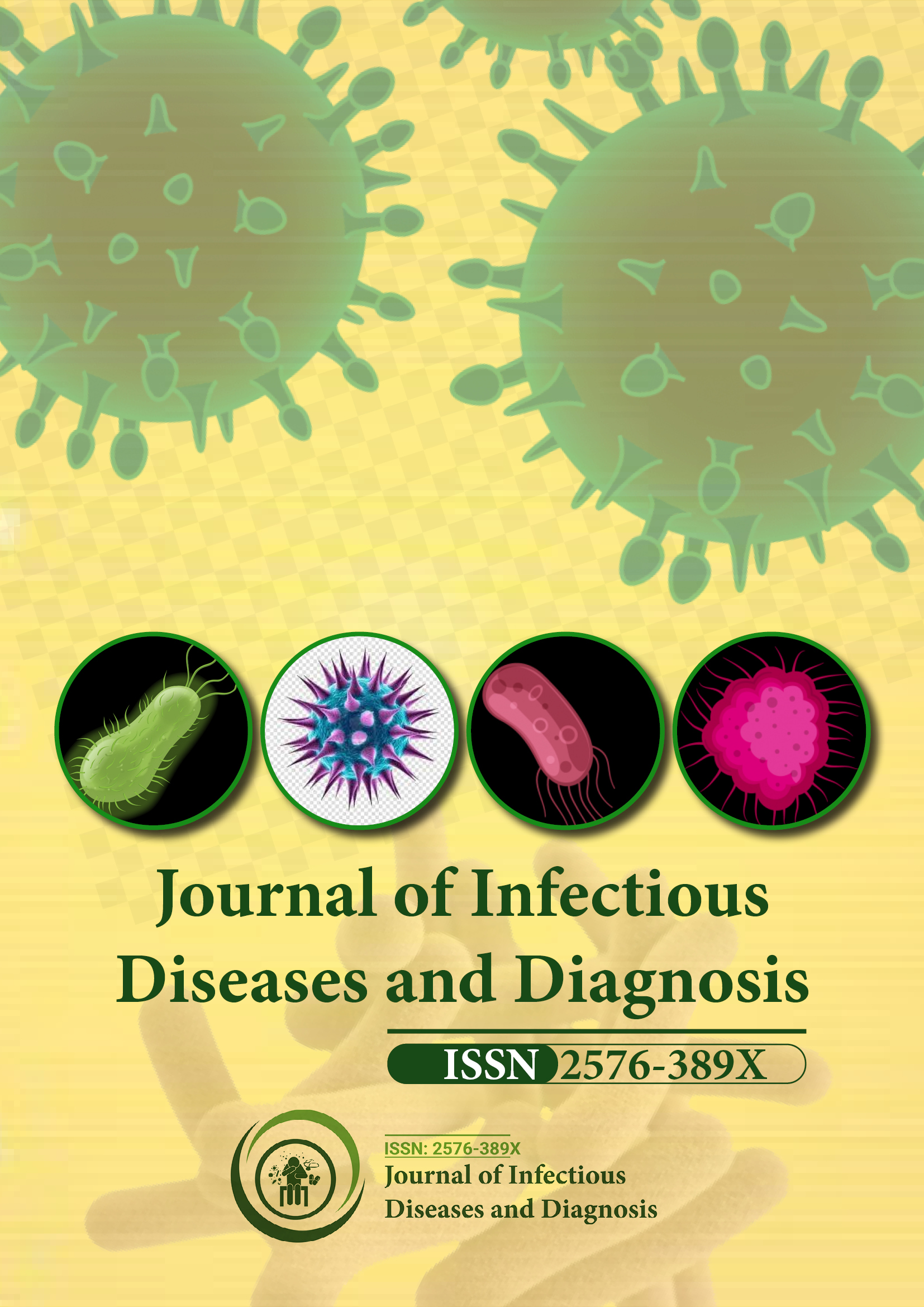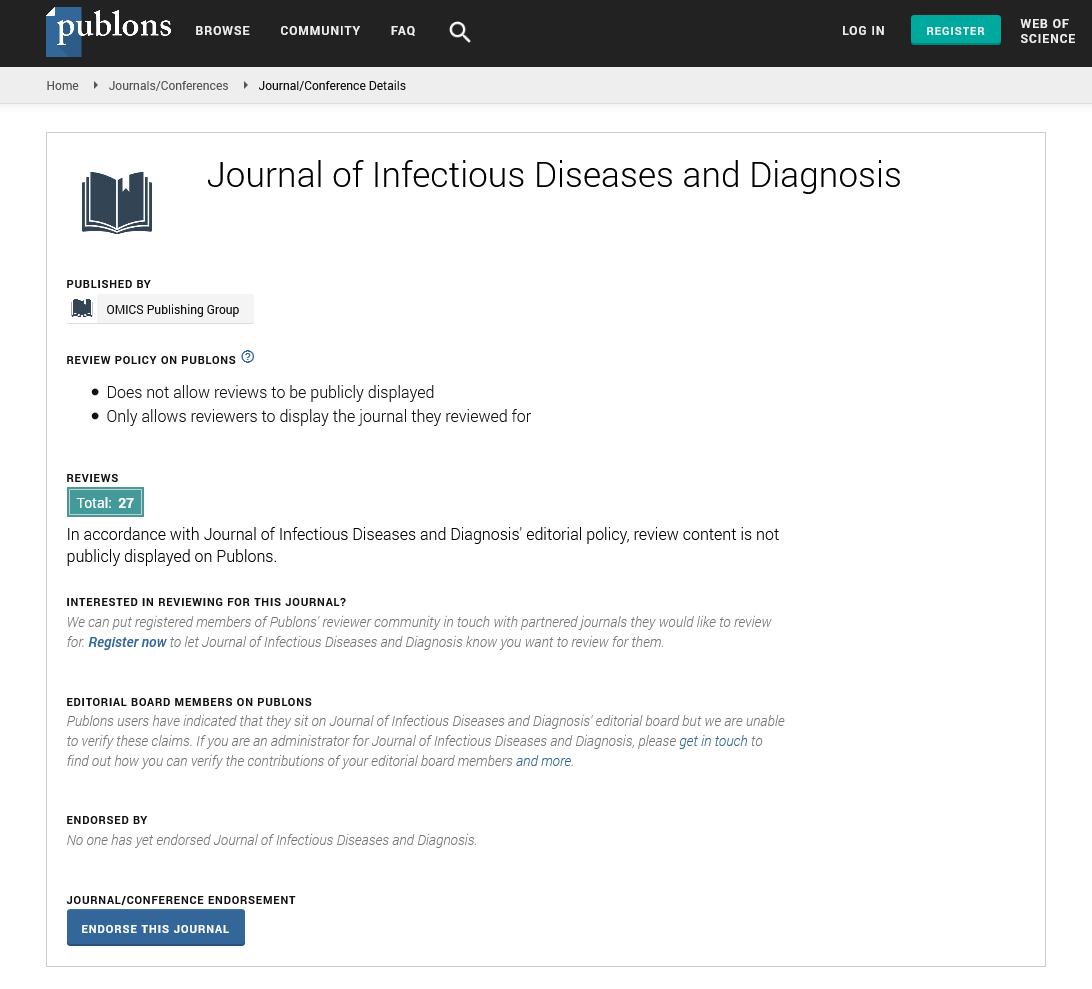Indexed In
- RefSeek
- Hamdard University
- EBSCO A-Z
- Publons
- Euro Pub
- Google Scholar
Useful Links
Share This Page
Journal Flyer

Open Access Journals
- Agri and Aquaculture
- Biochemistry
- Bioinformatics & Systems Biology
- Business & Management
- Chemistry
- Clinical Sciences
- Engineering
- Food & Nutrition
- General Science
- Genetics & Molecular Biology
- Immunology & Microbiology
- Medical Sciences
- Neuroscience & Psychology
- Nursing & Health Care
- Pharmaceutical Sciences
Research Article - (2021) Volume 6, Issue 4
Seasonal Incidence of Plasmodium in Anopheles Minimus, a Predominant Vector of Malaria in Manipur
Indira Yumnam*Received: 28-Dec-2020 Published: 08-Sep-2021
Abstract
Anopheles sp. is a primary vector of malaria in Manipur. Since no definite information was available regarding the status of vector of malaria in Manipur, the present study was undertaken to determine the prevalence of part of life cycle stage of Plasmodium in vector a species and their possible role in transmission of malaria. The communication records of the seasonal incidence of the three years 2001, 2002 and 2003 of Plasmodium in the host Anopheles minimus at Leingangpokpi village, Jiribam.
Keywords
Anopheles sp.. Seasonal incidence. Plasmodium. Leingangpokpi village.
Introduction
The genus Plasmodium included in the class-Sporozoasida of Phylum-Apicomplexa, was first discovered by Leveran, (1880), who was a doctor in the French Army stationed at Algiers. He observed Plasmodium in the blood of Malaria patient. In 1883, King reported that Plasmodium were transmitted through bite by the mosquitoes.
In 1886, Golgi confirmed the observation of Laveran. And the genus Pasmodium was named by Maechiafava and Celli, in 1885. In 1894, Manson suggested that the malarial parasite i.e Plasmodium enter the blood of man after the bite of mosquitoes.
Ross in 1985 proved that Plasmodium are sucked up by female Anopheles mosquitoes and are later injected into the human blood stream. Later, the life cycle of Plasmodium was described by Grassi (1989) which occured inside the stomach of Female Anopheles. Granham, Bird and Baker (1962) studied the ultrastructure of sporozoite in birds. In 1961, 1963 Granham et.al.,studied ultrastructure of sporozoites in human Table 1.
Materials and Methods
Anopheline mosquitoes were collected from human dwellings of different areas of Leingangpokpi (Jiribam) and its periphery with the help of suction tube in the morning and in the daytime during peak transmission season. Mosquitoes were anaesthetized with ether and identified with the help of regional pictorial keys [1]. Identified mosquitoes were dissected to look for salivary gland infection. Sporozoites positive slides were stained with Leishman’s, stain as described by Choudhary and Ghosh (1982) Figure1.

Figure 1: Results of dissection of the anophelines collected from human dwellings (August 2011 to October 2011).
Results and Observation
The results are sumarised in Table 1, 2. Of the three years (August 2011 to October 2011), (August 2012 to October 2012) and (August 2013 to October 2013), the higest sporozoites positivity rate was in the year 2012.
| Month | Number of Host Collected | Dissected Gland | Positive Gland | Sporozoite Positivity rate (%) |
|---|---|---|---|---|
| Aug-11 | 50 | 33 | 2 | 4 |
| Sep-11 | 54 | 34 | 3 | 5.5 |
| Oct-11 | 39 | 22 | 1 | 2.5 |
| Total | 143 | 89 | 6 | 4.1 |
Table -1: Results of dissection of the anophelines collected from human dwellings (August 2011 to October 2011).
| Month | Number of Host Collected | Dissected Gland | Positive Gland | Sporozoite Positivity rate (%) |
|---|---|---|---|---|
| Aug-11 | 50 | 33 | 2 | 4 |
| Sep-11 | 54 | 34 | 3 | 5.5 |
| Oct-11 | 39 | 22 | 1 | 2.5 |
| Total | 143 | 89 | 6 | 4.1 |
Table -2: Results of dissection of the anophelines collected from human dwellings (August 2012 to October 2012).
The year 2011, 2012 and 2013 show sporozoite positivity rate as 4. .1, 5.3 and 4 respectively. The above positivity rate is high which indicates that the region is a high transmission area. Though the vector Anopheles minimus was found in good numbers only 50 - 71% of the glands were dissected, of these 2.2% to 6.2% show sporozoite positivity rate.
At an average the positivity rate was 4.5% in all the three years of survey. Among these, the year 2012 show the highest sporozoite positivity rate (5.3%). This is in conformity with the higher number of malarial cases in Jiribam (September, in 2012). [ Source: A manual Book of State Malaria Department 2012].
In the year 2011 and 2013 malarial cases were 5.5%, 5.9% and 6.2% respectivity at Jiribam and adjoining areas.
In a similar were by Wajihullah and Saifi (2001) on Anopheles culicifacies in Aligarh sporozoite positivity rate was 0.396%, which is a low count for malaria transmission. But in a place like Aligarh which is not a high transmission region this is normal. [2,3]., (1986) also reported positivity rate of 0.490% from Meerut, wheras et al., (1986) reported higher sporozoite positivity rate of 0.823%, 1.005% and 2.89%. Prasad and Sharma (1990), reported similar observation from Bareilly and Shahjahanpur. Nagpal and Sharma (1986) reported positivity of 1.33% from Orissa for An. culifacies Figure 1.
Graph of the Seasonal incidence of Plasmodium in the Host Anopheles minimus:
Conclusion
The role of other vectors of malaria such as Anopheles annularis, Anopheles dirus and Anopheles stephensi could not be established in the present study as only a small number of these mosquitoes were dissected. It can however be added that these mosquitoes could have sporozoite positive glands during their ideal breeding seasons which could be the high dry months of summer or their breeding sites may be different from the present surveyed place.
REFERENCES
- Ansari, Z. A., Igole, B. S., and Parulekar, A. H. Effect of high organic enrichment on benthic polychaete population in am etuary. Mor. Poll. Bull., (1986), 17: 36 - 365.
- Chaudhary, S. K. and Ghosh, M. R. Influence of some modem insecticides on the incidence of Coccinella transversalis’Fab., A predator of Lipaphis erysimi Kalt. Sci Cult., (1982), 48 : 214 - 216.
- Garnham, P.C.C., Bird, R.G., Baker, J.R., and Bray, R.S. Electron microscope
- studies of motile stages of malaria parasites. II. The fine structure of the sporozoite of Laverania (Plasmodium) falcipara. Trans. Roy. Soc. Trop. Med. Hyg., (1961), 55: 98 - 102.
- Garnham, P.C.C., Bird, R.G., and Baker, J.R. Electron microscopic studies of motile stages of malarial parasites III. The ookinetes of Haemamoeba and Plasmodium. Trans. R. Soc. Trop. Med. Hyg., (1962), 56: 116 - 120.
- Garnham, P.C.C., Bird, R.G., and Baker, J.R. Electron microscopic studies of motile stages of malarial parasites. IV. The fine structure of the sporozoite of four species of Plasmodium. Trans. Roy. Soc. Trop. Med.Hyg., (1963), 61: 58 - 68.
- King, A.F.A. Insects and disease. Mosquitoes and malaria. Pop Sci., (1883), 23: 644 - 658.
- Golgi, C. Malarial infection. Arch. Sci .Med., (1886),10: 109-135.
- Grassi, G.B., Bignami, A., Bastianelli, G., Celli, A., Golgi, C.,and Marchiafava, E “Biodiversity of Malaria in the world”. (1989), 5.
- Laveran, C.A. “Centres for Disease Control and Prevention”.,CDC 24/7. Saving Lives Protecting People. (1980).
- Manson, P. "On the nature and significance of the crescentic and flagellated bodies in malarial blood". Brit Med J. (1894), 2 (4849): 8 - 1306.
- Marchiafava and Celli . Fortschr. Med., (1885).
- Nagpal, B.N., and Sharma, V.P. Incrimination of Anopheles culicifacies as vector of malaria in Orissa. Indian J. Malariol., (1986), 32 (1) : 57- 59.
- Prasad, R.N., and Sharma, S.N. Outbreak of malaria in Banda PHC of district Shahjahanpur (U.P.) Indian J. Malariol., (1990), 27: 47 - 50.
- Ross, R. “Malaria Tag Archives by Ronald Ross.” (1985).
- Wajihullah and Saifi M.A. Anopheles culicifacies, a predominant vector of malaria in Aligarh. J. Parasit. Dis., (2001), 25 (1): 48 - 49.
- Wattal, B. L., and Kalra, N. L. Region-wise pictorial keys to female Indian Anopheles. Bull. Natl. Soc. Ind. Mal. Mosq. Dis. (1961), 9: 85 - 130.
Citation: Yumnam I (2021) Seasonal incidence of Plasmodium in Anopheles minimus, a predominant vector of Malaria in Manipur. J Infect Dis Diagn. 6: 161
Copyright: © 2021 Yumnam I. This is an open-access article distributed under the terms of the Creative Commons Attribution License, which permits unrestricted use, distribution, and reproduction in any medium, provided the original author and source are credited.

